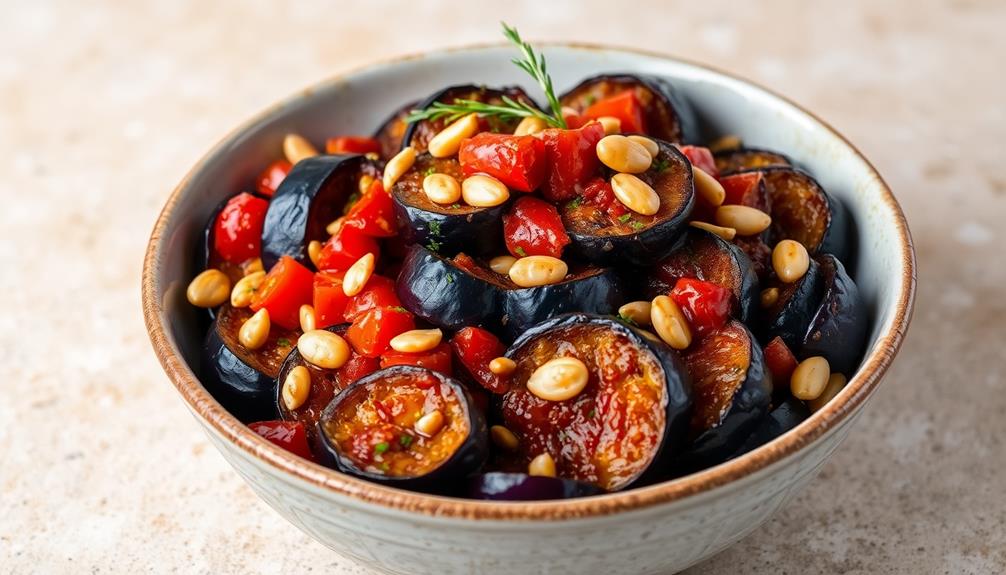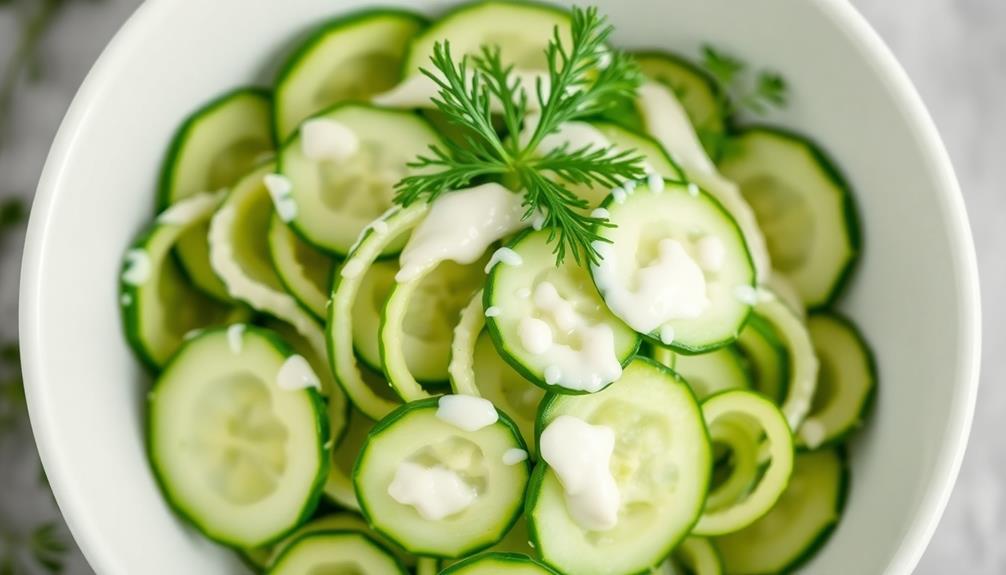Caponata is the beloved Sicilian specialty that'll transport you right to the sun-drenched streets of Italy! This delightful dish blends eggplant, tomatoes, and a medley of Mediterranean flavors. Traditionally made in the summer with fresh produce, it can be enjoyed as an appetizer, side, or even a main course. You'll love how the savory and sweet notes complement the natural taste of the eggplant. Serve it with crusty bread or use it as a topping for crostini. Caponata's versatility makes it a crowd-pleasing choice, and there's more to discover about this culinary gem from Sicily.
Key Takeaways
- Caponata is a classic Sicilian dish known for its rich culinary heritage, showcasing eggplant with Mediterranean ingredients.
- Caponata features a savory and sweet flavor profile that enhances the natural taste of eggplant, creating a satisfying experience.
- Caponata can be served as an appetizer, side dish, or main course, and is often accompanied by crusty bread or used as a topping for crostini.
- Caponata is a versatile dish that can be customized with additional Mediterranean ingredients, such as roasted red peppers, to suit individual preferences.
- Caponata is a nutritious dish that is naturally vegan, gluten-free, and suitable for a wide range of dietary needs, making it a popular choice for health-conscious individuals.
History
Caponata's origins can be traced back to Sicily, a region in Italy known for its rich culinary heritage. This beloved dish has been delighting taste buds for centuries, with its harmonious blend of flavors and textures.
Eggplant, the star ingredient, is sautéed to perfection, then combined with a tantalizing mix of tomatoes, onions, celery, and a touch of sweetness from raisins or sugar. The result is a symphony of savory and slightly tart notes, tempered by the richness of the eggplant.
What makes caponata so captivating is its versatility. It can be served as an appetizer, a side dish, or even the main event, complementing a wide range of Italian dishes.
The dish's origins are deeply rooted in the Sicilian culture, where it was traditionally prepared during the summer months, when the abundance of fresh produce made it a natural choice.
Today, caponata continues to be a beloved part of Sicilian cuisine, cherished by locals and visitors alike.
Recipe
Caponata is a classic Sicilian eggplant dish that's both savory and sweet. It's a wonderful way to showcase the natural flavors of eggplant, paired with a variety of Mediterranean ingredients. The combination of textures and flavors makes this dish a true delight.
Caponata is traditionally served as an appetizer or side dish, often accompanied by crusty bread. It can also be used as a topping for crostini, or as a filling for omelets or sandwiches. The dish is known for its ability to meld together different tastes, creating a harmonious and satisfying eating experience. In addition to its versatility in culinary applications, caponata is also a popular component of the traditional caprese salad recipe. The combination of sweet and sour flavors in caponata pairs perfectly with the fresh flavors of tomato, mozzarella, and basil in the caprese salad. This classic Italian dish is a testament to the enduring appeal of caponata in Mediterranean cuisine.
Ingredients:
- 1 large eggplant, cut into 1-inch cubes
- 1/4 cup olive oil
- 1 onion, diced
- 2 celery stalks, diced
- 3 garlic cloves, minced
- 1 (14-oz) can diced tomatoes
- 2 tablespoons red wine vinegar
- 2 tablespoons capers, rinsed and drained
- 1/4 cup pitted green olives, chopped
- 2 tablespoons sugar
- Salt and freshly ground black pepper to taste
Instructions:
In a large skillet, heat the olive oil over medium-high heat. Add the eggplant cubes and cook, stirring occasionally, until they're golden brown and tender, about 10-12 minutes. Transfer the eggplant to a plate and set aside.
In the same skillet, sauté the onion and celery until softened, about 5 minutes. Add the garlic and cook for another minute until fragrant. Stir in the diced tomatoes, red wine vinegar, capers, olives, and sugar. Season with salt and pepper to taste. Reduce the heat to low and simmer the mixture for about 15 minutes, stirring occasionally, until the flavors have melded.
Return the eggplant to the skillet and gently stir to combine. Serve warm or at room temperature.
When making caponata, be sure to taste and adjust the seasoning as needed. The dish should have a balance of sweet, sour, and savory flavors. You can also experiment with adding other Mediterranean ingredients, such as roasted red peppers or chopped basil, to customize the dish to your liking.
Cooking Steps
Dice the eggplant into 1-inch cubes and get ready to cook!
Next, sauté the onions until they're nice and translucent.
Now, add the tomatoes and capers, then pour in the vinegar and sugar.
Let it all simmer together until the eggplant is tender and delicious.
Step 1. Dice Eggplant Into 1-Inch Cubes
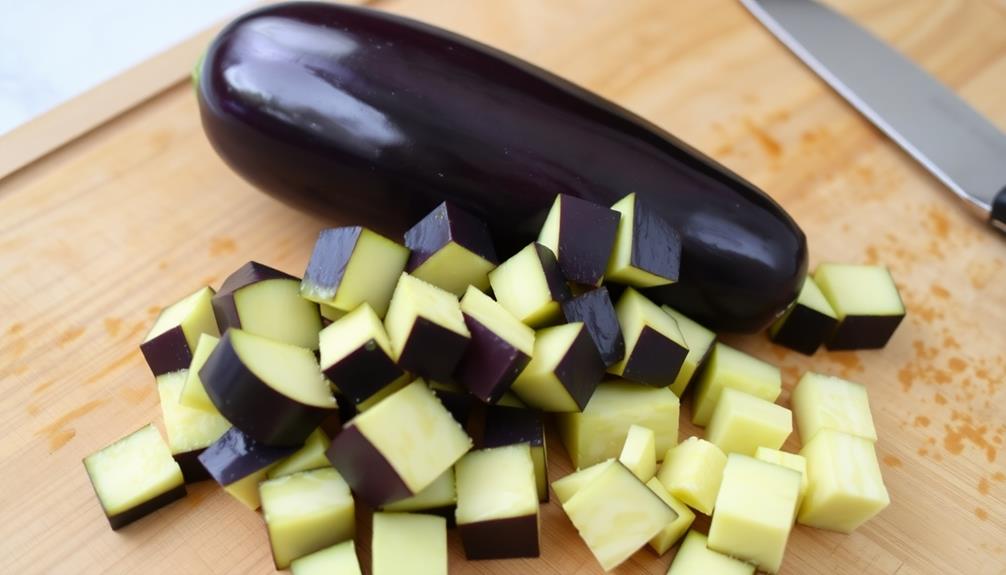
Begin by trimming the eggplant's ends and slicing it into 1-inch thick rounds. You'll then need to dice those rounds into 1-inch cubes. This step is important for ensuring even cooking and allowing the caponata flavors to meld together perfectly.
Grab your sharpest knife and get to work! Carefully slice the eggplant into 1-inch thick rounds, then stack a few at a time and cut them into 1-inch cubes. Work quickly and with confidence – you've got this!
The goal is to end up with a pile of evenly-sized eggplant pieces that will cook through nicely.
Once you've diced the entire eggplant, you're ready to move on to the next step. The small, uniform cubes will help the eggplant absorb all the delicious flavors in the caponata recipe. Get excited, because you're well on your way to a mouthwatering Mediterranean dish!
Step 2. Sauté Onions Until Translucent

Next, you'll want to sauté the onions until they're translucent.
In your large skillet, add a bit of olive oil and turn the heat to medium. Toss in the diced onions and let them sizzle away.
As they cook, the onions will become soft and start to turn a lovely golden color. Keep an eye on them, stirring occasionally, until they reach that perfect translucent state – not too brown, not too raw.
You'll know they're ready when they're sweet-smelling and tender. Ah, the aroma of sautéed onions is simply irresistible!
Once your onions are just right, it's time to move on to the next step in creating your delicious caponata. Get ready for some more veggie magic!
Step 3. Add Tomatoes and Capers

With the onions now fragrant and translucent, it's time to add the tomatoes and capers. Grab a can of diced tomatoes and pour them into the sizzling pan. The juicy tomatoes will release their tangy flavor, blending beautifully with the onions.
Next, sprinkle in a few tablespoons of briny capers. These little flower buds add a delightful pop of salty goodness to the dish. Stir everything together, letting the flavors meld and the mixture simmer gently.
As the caponata simmers, the tomatoes will soften, and the capers will infuse their distinctive taste throughout. This is the perfect time to season with a pinch of salt and a grind of black pepper. Taste and adjust the seasoning as needed, ensuring a perfect balance of sweet, sour, and savory.
With the tomatoes and capers incorporated, you're well on your way to creating an authentic and mouthwatering caponata. Get ready for the next step!
Step 4. Add Vinegar and Sugar
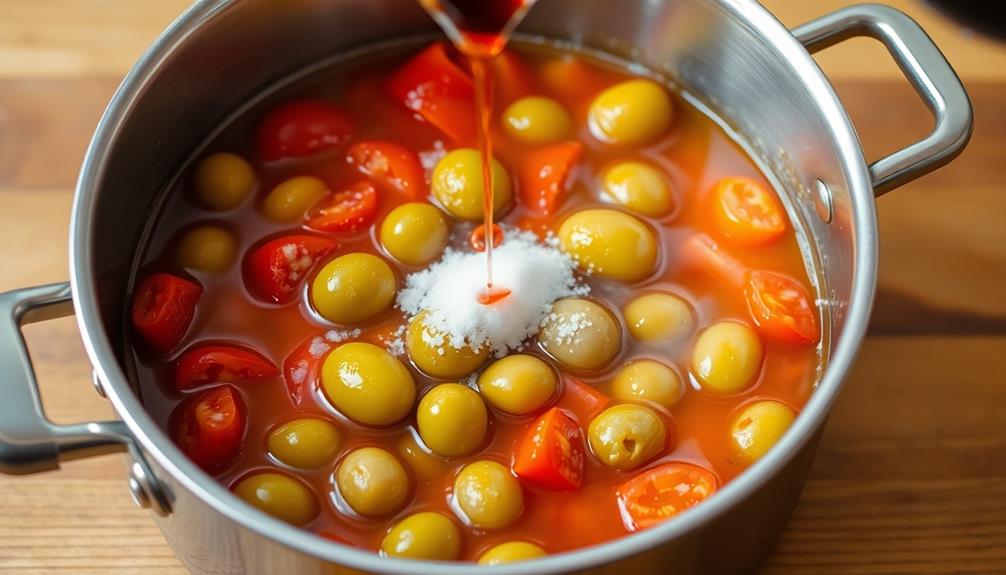
Now, pour in the red wine vinegar and granulated sugar. These two ingredients will give your caponata the perfect balance of sweet and tangy flavors.
Stir everything together until the sugar has fully dissolved. You'll notice the mixture taking on a lovely, glossy sheen as the vinegar and sugar meld together.
Next, let the caponata simmer for 10-15 minutes, stirring occasionally. This allows the flavors to meld and intensify.
You'll know it's ready when the vegetables are tender and the sauce has thickened slightly. Feel free to adjust the amount of vinegar and sugar to suit your personal taste preferences. A little more vinegar for a tangier bite, or a touch more sugar for a sweeter touch.
Once the caponata has reached the perfect flavor balance, it's ready to serve! Spoon it onto crusty bread or crackers for a delightful appetizer.
Enjoy the tantalizing blend of sweet, sour, and savory in every bite.
Step 5. Simmer Until Eggplant Is Tender
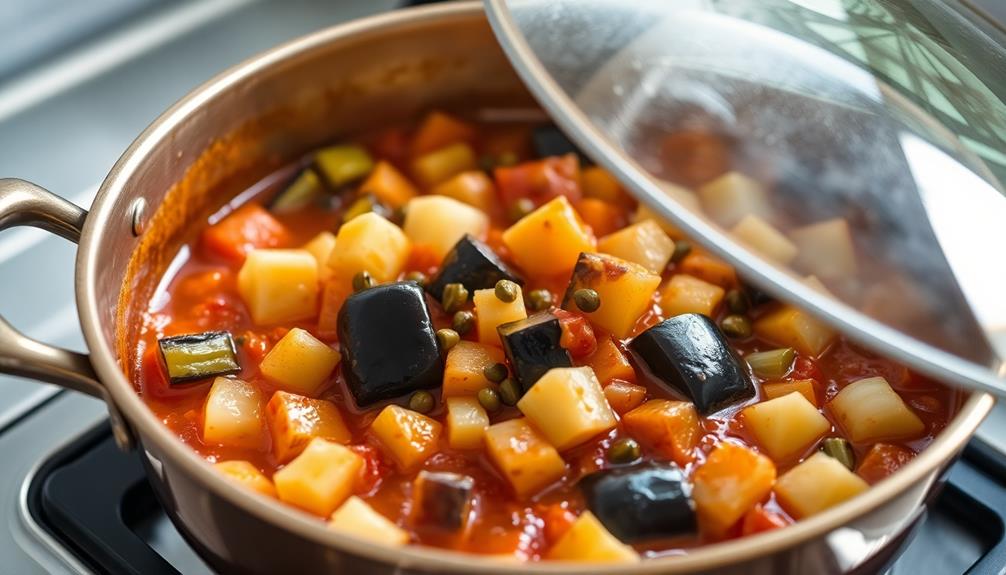
After adding the vinegar and sugar, allow the caponata to simmer for 10-15 minutes, stirring occasionally. This gentle simmering will tenderize the eggplant and allow all the flavors to meld together beautifully.
As the caponata bubbles away, you'll notice the kitchen filling with the most enticing aroma. The sweet and tangy scents will have your mouth watering in anticipation. Be sure to keep an eye on the pot, giving it a stir every few minutes to prevent sticking.
Once the eggplant is fork-tender, you'll know the caponata is ready. The vegetables should be soft and infused with the zesty vinegar and warm spices. This is the perfect time to give the mixture a final taste and adjust the seasoning if needed.
With the eggplant perfectly cooked, you're one step closer to enjoying this classic Sicilian dish. Get ready for an explosion of flavor in every bite!
Final Thoughts
As you round out your culinary journey with caponata, consider how this Sicilian delicacy can elevate your meals. Its bold flavors and vibrant colors make it a showstopper, perfect for impressing guests at your next gathering. Serve it as an appetizer with crusty bread, or use it as a versatile topping for grilled meats, fish, or roasted vegetables. The possibilities are endless!
Beyond its delicious taste, caponata is a nutritious addition to any diet. The eggplant, tomatoes, and olives provide a wealth of vitamins, minerals, and antioxidants to nourish your body.
Plus, the dish is naturally vegan and gluten-free, making it a crowd-pleasing option for a variety of dietary needs.
As you savor the final bites of your caponata, remember that this Sicilian specialty isn't just a meal – it's a celebration of the bountiful flavors of the Mediterranean.
Embrace the joy of sharing this cultural delight with your loved ones and let it inspire you to explore more of the rich culinary traditions from around the world.
Frequently Asked Questions
How Long Does Caponata Last in the Refrigerator?
Properly stored, caponata can last 3-5 days in the refrigerator. Make sure to keep it in an airtight container and consume it before it starts to spoil. Enjoy your tasty caponata while it's fresh!
Can Caponata Be Frozen for Later Use?
Yes, you can freeze caponata for later use. It'll keep in the freezer for up to 3 months, preserving its flavor and texture. Just be sure to thaw it in the fridge before serving.
Is Caponata Gluten-Free?
Yes, caponata is typically gluten-free. As it's made primarily with eggplant, tomatoes, onions, and other naturally gluten-free ingredients, caponata is a safe option for those following a gluten-free diet. You can enjoy this flavorful Sicilian dish without worry.
What Can I Serve Caponata With?
You can serve caponata with a variety of dishes. It pairs well with crusty bread, crackers, or crostini as an appetizer. You can also serve it alongside grilled meats, fish, or roasted vegetables for a flavorful side dish.
How Spicy Is Traditional Caponata?
Traditional caponata isn't overly spicy, though some recipes may include a bit of heat from ingredients like red pepper flakes. The flavors are more savory and sweet, with eggplant, tomatoes, and vinegar being the stars of the dish.
